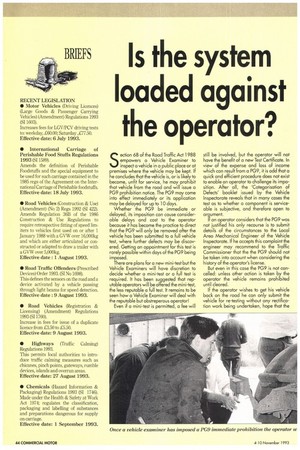Is the system loaded against the operator?
Page 46

Page 47

If you've noticed an error in this article please click here to report it so we can fix it.
Section 68 of the Road Traffic Act 1988 empowers a Vehicle Examiner to inspect a vehicle in a public place or at premises where the vehicle may be kept. IF he concludes that the vehicle is, or is likely to become, unfit for service, he may prohibit that vehicle From the road and will issue a PG9 prohibition notice. The PG9 may come into effect immediately or its application may be delayed for up to 10 days. Whether the PG9 be immediate or delayed, its imposition can cause considerable delays and cost to the operator because it has become the practice to direct that the PG9 will only be removed after the vehicle has been submitted to a Full vehicle test, where further defects may be discovered. Getting an appointment For this test is rarely possible within days of the PG9 being imposed.
There are plans For a new mini-test but the Vehicle Examiners will have discretion to decide whether a mini-test or a full test is required. It has been suggested that reputable operators will be offered the mini-test, the less reputable a full test. It remains to be seen how a Vehicle Examiner will deal with the reputable but obstreperous operator! Even if a mini-test is permitted, a fee will
still be involved, but the operator will not have the benefit of a new Test Certificate. In view of the expense and loss of income which can result from a PG9, it is odd that a quick and efficient procedure does not exist to enable an operator to challenge its imposition. After all, the 'Categorisation of Defects' booklet issued by the Vehicle Inspectorate reveals that in many cases the test as to whether a component is serviceable is subjective, and therefore open to argument. If an operator considers that the PG9 was not justified his only recourse is to submit details of the circumstances to the Local Area Mechanical Engineer of the Vehicle Inspectorate. If he accepts this complaint the engineer may recommend to the Traffic Commissioner that the the PG9 should not be taken into account when considering the history of the operator's license. But even in this case the PG9 is not cancelled: unless other action is taken by the operator the vehicle remains prohibited until cleared.
IF the operator wishes to get his vehicle back on the road he can only submit the vehicle for re-testing without any rectification work being undertaken, hope that the Vehicle Examiner passes the vehicle, and then make an immediate complaint. If removal of the prohibition is refused the operator can apply to any Traffic Commissioner to have the vehicle re-inspected. Within seven days of that inspection the operator must be notified in writing if the prohibition is to be removed. Once again, the delay will cost time and money.
The only other course open to the operator is to lodge a formal appeal against the Vehicle Examiner's refusal to remove the prohibition. Such an appeal must be made in writing to the Goods Vehicle Centre at Swansea within 14 days of the refusal, setting out the grounds for the appeal.
But no time limit is imposed on Swansea and the vehicle remains out of action until the Vehicle Examiner is prepared to remove the prohibition.
With the prospect of the Vehicle Inspectorate and Test Stations being privatised perhaps some attention should be given to introducing a faster procedure.
This would enable an operator to challenge the imposition of a PG9 without being penalised by the vehicle being off the road-, sometimes for several weeks, while an appeal or complaint is dealt with.




























































































